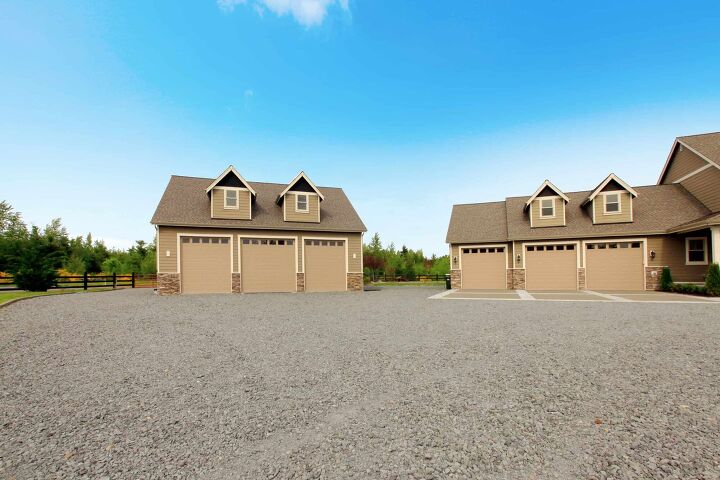Can You Build A Garage Over A Septic Field?

Many homeowners choose to add a garage to their home after it’s already been built. Doing so is an excellent way to add value to your home and give yourself some extra space for storage and parking.
However, if you have a septic field, you need to be careful about where you build a garage. Constructing one in the wrong place could seriously impede your ability to access parts of your septic system.
You should never build a garage over any part of your septic field. This is because doing so would make it virtually impossible to drain your septic tank or perform other types of septic field maintenance. Even if these things weren’t an issue, putting too much weight on top of your septic field can damage it.
Do You Need to Hire Garage Builders or Contractors?
Get free, zero-commitment quotes from pro contractors near you.

What is a Septic Field?
Septic field is another word that’s used to describe a septic system. These are underground wastewater treatment structures that are common in rural areas and other places without centralized sewer systems.
A typical septic system features three distinct parts, a tank, a drainfield, and a soil absorption field. These components work together to collect wastewater, treat it, and prepare it to be distributed back into the earth.
Keeping your septic field functioning properly is an important part of keeping your home functioning. Without a working septic field, you’ll run into a number of plumbing issues that can be costly to repair.
This is why it’s important that you follow the best advice for keeping your septic field functioning optimally. Doing so will save you thousands in repair and hours of your time and energy.
How to Find the Boundaries of a Septic Field
Before starting construction on a new garage, you need to know exactly where your septic field ends. Failing to do this could cause you to inadvertently build on top of the field, threatening the integrity of your entire septic system.
To find the boundaries of a septic field, first, consult with your home’s blueprints. You may be able to find exactly where the system begins and ends without having to go out and look for this information yourself.
If that doesn’t work, you can trace the plumbing drain lines from your home to your septic tank. Typically, tanks are installed within 10 to 20 feet from your home’s exterior.
You can also check the natural slope of your land to locate the leach field. Never use heavy machinery in this process, as doing so could cause serious damage to your septic system or a utility line. You should also consult with your local electric utility or gas provider before digging for your septic system.
You may also want to use a septic tank probe before digging. These are thin, long sticks that you push into the ground. You can use one to identify the edges of your tank or the pipes leading away from it without having to do any heavy digging.
How Much Weight Can You Put on Top of a Septic Tank?
One of the reasons that you shouldn’t build on top of a septic tank is because they’re not meant to withstand so much weight. It’s worth keeping this fact in mind to make sure you don’t place other items on your septic field that weigh too much.
Unfortunately, there is no exact weight limit for most septic systems. However, professionals advise not to park any vehicles or heavy machinery on top of a septic tank. Even small vehicles like ATVs, golf carts, and Mini Coopers are heavy enough to damage a septic tank.
For that reason, you shouldn’t drive or park any vehicles on top of your septic field. Doing so repeatedly could seriously damage your septic tank lid, possibly causing a cave-in.
How Far Does a Septic Tank Need to Be From a Garage?
Even though you can’t build a garage over a septic field, adding one to your property could still be a good idea. You just need to be mindful of how far you place the new addition away from a septic field.
Most states and cities have specific codes for how far certain additions need to be away from septic systems. For example, in Massachusetts, a garage needs to be 10 feet from a septic tank and 10 feet from the leaching area.
You may have to build your garage even further from your septic field if you live in a state with more stringent requirements. Regardless, be sure to check your state and city code before adding a new garage near your septic system.
What Can You Put Over a Septic Field?
Although it may be frustrating to not be able to build over a septic field, you can still landscape on top of it. You just need to be careful about how you do this.
First, you need to identify the exact location of your septic tank’s access port. You don’t want to cover it up completely. Otherwise, you would need to tear out your landscaping every time that you need to drain your tank or make other septic system repairs.
Second, only certain types of vegetation are safe to grow over a septic tank. Limit what you plant here to plants that are small and have roots that don’t penetrate too deeply into the ground.
Trees and other tall plants should be planted at least 20 feet away from a septic tank. If you fail to do this, the roots could grow deep enough to threaten the structural integrity of the tank.
Finally, you can add architectural features on top of a septic tank. However, make sure that you don’t add any that are too heavy. Doing so could lead to issues like septic tank leaks and pipe rupture.
Can You Build a Garage Over a Drainfield?
Unfortunately, the answer to this question is also no. The issues associated with building over a drainfield are very similar to what you would encounter after building on top of a septic tank.
Drainfields are the part of your septic system that decontaminates wastewater. They need to be built in areas where the soil is properly aerated.
If you build on top of your drainfield, you risk compacting the soils that your drainfield relies on to decontaminate wastewater. This process could seriously damage the underground apparatus that allows the drainfield to function.
When this happens, your entire septic system could fail. That’s why it’s so important that you don’t build on top of a drainfield. Instead, move your planned addition 10-20 feet away from your drainfield to ensure it won’t harm it.
Can You Put a Driveway Over a Septic Field?
No, you cannot put a driveway over a septic field. Once again, you would run into similar issues to the ones discussed above. You shouldn’t ever drive or park on top of a septic field. Doing so can compact the field’s soil, cause pipes to burst, and even lead to a cave-in.
Ultimately, the only thing that you can put on top of a septic field is landscaping. Anything heavier than simple plants can lead to a number of costly and time-consuming issues that will impact your home’s plumbing system.
Do You Need to Hire Garage Builders or Contractors?
Get free, zero-commitment quotes from pro contractors near you.

Related Questions
Can you put pavers over a septic drainfield?
Yes, pavers are one of the few items that you can safely place on top of a septic drainfield. Just be sure that you haven’t placed too many very heavy pavers over the drainfield. Add too many of these and you could run into similar issues to the ones described above.
How deep are septic field lines buried?
Septic field lines are generally only placed between 18 and 30 inches below the surface of your yard. The maximum amount of soil cover you can expect to have is about three feet. This means that your septic lines may be closer to the surface than you would have thought.
How do I know if my drainfield is failing?
If you’ve already built over a drainfield, there are several signs you can look for to see whether it’s failing. These include sewage odors, slow-running drains, and a surrounding area that is wet, mushy, or even has standing water. If you notice any of these issues, be sure to take immediate steps to fix the problem.

Kellan is a content writer who specializes in everything DIY. When he's not behind the keyboard, he enjoys spending time with his pets, playing music, and geeking out about basketball. He hopes to make your home improvement projects a little bit easier to accomplish.
More by Kellan Jansen













![Finishing Basement Without Permit [Is It Really Illegal?]](https://cdn-fastly.upgradedhome.com/media/2023/07/31/9070078/finishing-basement-without-permit-is-it-really-illegal.jpg?size=350x220)
![The 5 Best Angle Grinders – [2022 Reviews & Buyer's Guide]](https://cdn-fastly.upgradedhome.com/media/2023/07/31/9071326/the-5-best-angle-grinders-2022-reviews-buyer-s-guide.jpg?size=350x220)












